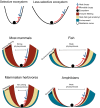Comparative gut microbiome research through the lens of ecology: theoretical considerations and best practices
- PMID: 39530277
- PMCID: PMC11885713
- DOI: 10.1111/brv.13161
Comparative gut microbiome research through the lens of ecology: theoretical considerations and best practices
Abstract
Comparative approaches in animal gut microbiome research have revealed patterns of phylosymbiosis, dietary and physiological convergences, and environment-host interactions. However, most large-scale comparative studies, especially those that are highly cited, have focused on mammals, and efforts to integrate comparative approaches with existing ecological frameworks are lacking. While mammals serve as useful model organisms, developing generalised principles of how animal gut microbiomes are shaped and how these microbiomes interact bidirectionally with host ecology and evolution requires a more complete sampling of the animal kingdom. Here, we provide an overview of what past comparative studies have taught us about the gut microbiome, and how community ecology theory may help resolve certain contradictions in comparative gut microbiome research. We explore whether certain hypotheses are supported across clades, and how the disproportionate focus on mammals has introduced potential bias into gut microbiome theory. We then introduce a methodological solution by which public gut microbiome data of understudied hosts can be compiled and analysed in a comparative context. Our aggregation and analysis of 179 studies shows that generating data sets with rich host diversity is possible with public data and that key gut microbes associated with mammals are widespread across the animal kingdom. We also show the effects that sample size and taxonomic rank have on comparative gut microbiome studies and that results of multivariate analyses can vary significantly with these two parameters. While challenges remain in developing a universal model of the animal gut microbiome, we show that existing ecological frameworks can help bring us one step closer to integrating the gut microbiome into animal ecology and evolution.
Keywords: comparative; ecology; evolution; gut microbiome; host–microbe interactions.
© 2024 The Author(s). Biological Reviews published by John Wiley & Sons Ltd on behalf of Cambridge Philosophical Society.
Figures




Similar articles
-
Universal gut microbial relationships in the gut microbiome of wild baboons.Elife. 2023 May 9;12:e83152. doi: 10.7554/eLife.83152. Elife. 2023. PMID: 37158607 Free PMC article.
-
Host phylogeny and functional traits differentiate gut microbiomes in a diverse natural community of small mammals.Mol Ecol. 2023 May;32(9):2320-2334. doi: 10.1111/mec.16874. Epub 2023 Feb 19. Mol Ecol. 2023. PMID: 36740909
-
Host diet drives gut microbiome convergence between coral reef fishes and mammals.Mol Ecol. 2024 Oct;33(19):e17520. doi: 10.1111/mec.17520. Epub 2024 Aug 28. Mol Ecol. 2024. PMID: 39205506
-
Current knowledge of the Southern Hemisphere marine microbiome in eukaryotic hosts and the Strait of Magellan surface microbiome project.PeerJ. 2023 Oct 3;11:e15978. doi: 10.7717/peerj.15978. eCollection 2023. PeerJ. 2023. PMID: 37810788 Free PMC article. Review.
-
Microbiome influence on host community dynamics: Conceptual integration of microbiome feedback with classical host-microbe theory.Ecol Lett. 2021 Dec;24(12):2796-2811. doi: 10.1111/ele.13891. Epub 2021 Oct 4. Ecol Lett. 2021. PMID: 34608730 Free PMC article. Review.
Cited by
-
Gut microbiome and diet contribute to ecological niche differentiation between argali (Ovis ammon hodgsoni) and blue sheep (Pseudois nayaur) on the Qinghai-Tibet Plateau.Commun Biol. 2025 Jun 16;8(1):930. doi: 10.1038/s42003-025-08185-7. Commun Biol. 2025. PMID: 40523923 Free PMC article.
References
-
- * Akhremchuk, K. , Skapavets, K. , Akhremchuk, A. , Kirsanava, N. , Sidarenka, A. & Valentovich, L. (2022). Gut microbiome of healthy people and patients with hematological malignancies in Belarus. Microbiology Independent Research Journal (MIR Journal) 9, 18–30.
-
- Amato, K. R. , Sanders, G. , Song, S. J. , Nute, M. , Metcalf, J. L. , Thompson, L. R. , Morton, J. T. , Amir, A. , McKenzie, V. J. , Humphrey, G. , Gogul, G. , Gaffney, J. , Baden, A. L. , Britton, G. A. O. , Cuozzo, G. F. P. , et al. (2018). Evolutionary trends in host physiology outweigh dietary niche in structuring primate gut microbiomes. The ISME Journal 13, 576–587. - PMC - PubMed
Publication types
MeSH terms
Grants and funding
LinkOut - more resources
Full Text Sources
Miscellaneous

